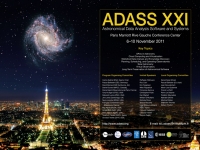Steven Beard (UK Astronomy Technology Centre),
J. Morin (DIAS, Ireland), R. Gastaud (CEA,
France), R. Azzollini (CSIC, Spain), P. Bouchet (CEA, France), S.
Chaintreuil (LESIA, France), F. Lahuis (SRON, Netherlands) and C.
Nehme (CEA, France)
Abstract
The JWST Mid Infrared Instrument (MIRI)
operates in the 5-28 micron wavelength range and can be configured for
imaging, coronographic imaging, long-slit, low-resolution spectroscopy
or medium resolution spectroscopy with an integral field
unit.
SCASim is one of a suite of simulators which operate
together to simulate all the different modes of the instrument. These
simulators are essential for the efficient operation of MIRI; allowing
more accurate planning of MIRI observations on sky or during the
pre-launch testing of the instrument. The data generated by the
simulators are essential for testing the data pipeline software. The
simulators not only need to reproduce the behaviour of the instrument
faithfully, they also need to be adaptable so that information learned
about the instrument during the pre-launch testing and in-orbit
commissioning can be fed back into the simulation.
SCASim
simulates the behaviour of the MIRI detectors, taking into account
cosmetic effects, QE, shot noise, dark current, read noise, amplifier
layout, cosmic ray hits, etc... The software has benefited from two
major design choices: First, the development of a suite of MIRI
simulators, rather than single simulator, has allowed MIRI simulators
to be developed in parallel by different teams, with each simulator
able to concentrate on one particular area. SCASim provides a facility
common to all the other simulators and saves duplication of effort.
Second, SCASim has a Python-based object-oriented design which makes
it easier to adapt as new information about the instrument is learned
during testing. These design choices have made SCASim highly reusable.
In its present form it can be used to simulate any JWST detector, and
it can be adapted for future instruments with similar, photon-counting
detectors.
Poster in PDF format
Paper ID: P007
Poster Instructions
|

